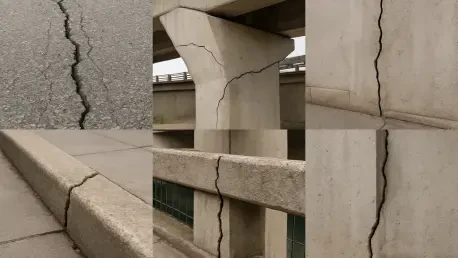What if the bridge crossed daily by thousands conceals a hairline fracture, invisible to the naked eye, yet capable of triggering a catastrophic failure under the right conditions? This silent threat looms over aging civil infrastructure worldwide, from towering dams to sprawling highways. Despite technological strides, many structural flaws remain undetected until disaster strikes, costing lives and billions in damages. Could artificial intelligence (AI), paired with cutting-edge tools, finally offer a solution to spot these dangers before it’s too late?
Why Cracks Slip Through the Net
Detecting cracks in infrastructure like bridges or wind turbine towers has long been a daunting task. Manual inspections, often conducted by workers scaling heights or navigating hazardous zones, miss subtle defects due to human limitations and inconsistent coverage. Even with modern tools, the sheer scale of global infrastructure—spanning millions of miles—overwhelms traditional methods, leaving critical flaws hidden in plain sight.
The stakes couldn’t be higher. A single overlooked fracture can compromise an entire structure, as seen in high-profile collapses that have shaken public trust. With many structures built decades ago now reaching the end of their design life, the urgency to improve detection systems has never been more pressing. This gap in reliability sets the stage for exploring whether technology can bridge the divide.
The Critical Demand for Smarter Monitoring
Structural health monitoring is not just about maintenance; it’s a cornerstone of public safety and economic stability. Failing infrastructure disrupts commerce, halts transportation, and endangers communities, with repair costs often soaring into the hundreds of millions. Traditional approaches, reliant on manual labor in risky conditions, fall short in both efficiency and accuracy, exposing workers to unnecessary danger.
Unmanned aerial vehicles (UAVs) have emerged as a safer alternative, offering a bird’s-eye view of hard-to-reach areas. Yet, even this advancement struggles with human dependency for operation and analysis, leading to inconsistent results. The growing catalog of infrastructure failures underscores the need for a system that can operate independently, ensuring no crack goes unnoticed in an era of deteriorating assets.
AI and UAVs: A Game-Changing Duo
The fusion of AI with UAVs marks a revolutionary step in crack detection for civil infrastructure. Equipped with RGB cameras and onboard processing units like the Jetson Nano, these drones capture high-resolution images and analyze them in real-time. Advanced segmentation models create binary masks to pinpoint cracks with precision, achieving an impressive 85% capture rate in training datasets and 82% in testing scenarios.
Beyond detection, deep reinforcement learning (DRL) empowers UAVs to navigate autonomously along crack patterns, adapting to complex surfaces while optimizing battery life. Studies report a 64% efficiency gain over traditional exhaustive search methods, such as raster scanning, by focusing only on areas of concern. Visual data, including mapped trajectories, showcases how these systems trace flaws with surgical accuracy, redefining inspection standards.
This technology isn’t just theoretical. Deployments on critical structures reveal how AI-driven drones cover vast areas in less time, reducing human involvement and enhancing safety. The potential to scale this approach could transform how entire cities monitor their infrastructure, making routine checks faster and far more reliable.
Expert Perspectives on AI’s Role
Insights from leading voices in civil engineering bolster the case for AI-driven inspections. Prof. Rih-Teng Wu, a key researcher in autonomous systems, highlights the profound impact of this technology, noting that it slashes labor costs while significantly improving safety outcomes. This perspective aligns with a broader industry shift toward automation, where minimizing human error is a top priority.
Real-world applications further validate these claims. Pilot projects on aging bridges and dams have demonstrated how UAV-based inspections identify issues missed by conventional methods, preventing potential disasters. Industry experts agree that integrating AI into routine maintenance could become standard practice within the next few years, especially as data from ongoing deployments continues to show consistent benefits.
One notable case involved a major highway overpass where an AI-equipped drone detected micro-fractures invisible during manual checks. Such examples underscore the technology’s ability to uncover hidden risks, offering a glimpse into a future where infrastructure failures might be predicted and prevented with unprecedented accuracy.
Steps to Integrate AI into Inspections
Adopting AI for infrastructure monitoring requires a strategic approach tailored to existing challenges. The first step involves assessing current inspection gaps, prioritizing high-risk structures like old bridges or overworked dams for autonomous monitoring. This targeted focus ensures resources are allocated where they’re needed most, maximizing impact from the outset.
Collaboration with technology providers is essential to deploy UAVs equipped with customized AI models for crack segmentation. Training staff to oversee these systems and interpret data outputs remains critical, blending human expertise with automation for optimal results. Starting with pilot projects on critical assets can build confidence in the technology, showcasing measurable gains in efficiency and safety.
Scaling this solution also demands addressing logistical hurdles, such as regulatory approvals and integration with existing maintenance protocols. By tackling these barriers systematically, stakeholders can pave the way for widespread adoption, ensuring that AI becomes a cornerstone of infrastructure management. The path forward lies in a commitment to innovation, balancing technological advancements with practical implementation.
Reflecting on a Safer Tomorrow
Looking back, the journey to revolutionize crack detection in civil infrastructure revealed both the depth of the challenge and the promise of AI as a transformative force. The integration of autonomous UAVs with advanced algorithms tackled long-standing issues of safety, efficiency, and accuracy, setting a new benchmark for structural health monitoring. Each step—from pilot projects to expert endorsements—underscored the potential to avert disasters through timely intervention.
Moving ahead, the focus shifts to actionable progress. Governments and private entities need to invest in scaling these technologies, prioritizing vulnerable structures for immediate attention. Partnerships between engineers and tech innovators are crucial to refine systems further, ensuring adaptability across diverse environments. The vision of a world where no crack goes undetected demands sustained effort, but the foundation laid by these advancements offers hope for safer, more resilient infrastructure in the years to come.









